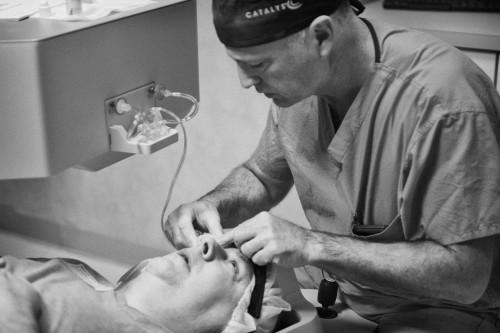Cataract surgery is among the safest and most common forms of surgery performed today. Advances in technology have made cataract treatment less invasive, reduced recovery time, and enhanced the quality of vision after the procedure.
Cataracts Are A Common Vision Disorder
Cataracts are the leading cause of blindness in adults over 40. Cataracts occur when the natural lens of our eyes becomes cloudy over time. Surgery is needed to remove and replace defective lenses.
Today, cataract surgery is an outpatient procedure. At Dr. Silverman’s office, it only takes around 5-10 minutes to complete. If both eyes require surgery, Dr. Silverman will space these procedures out, usually waiting a week or two between surgeries.
Pre-Operative
The first part of the cataract procedure requires that your eyes be dilated with special drops. Topical anesthesia is then administered to numb the area and prepare for the surgery. In addition to the anesthesia, you might also receive a sedative to relax you during the procedure.
The Surgical Procedure
There are two types of cataract surgery performed today, both of which are available at OCLI. One uses the standard incision made with a knife, while HD cataract surgery uses the femtosecond laser. Cataract surgery typically consists of two components:
Removal of the cataract: Dr. Silverman makes a small incision in the cornea. This procedure can be done manually, or carried out by advanced imaging systems. During the laser procedure, a precise 3D map is made of your eye, which guides the laser as it makes the incision.
Once the incision has been made in the cornea, Dr. Silverman then inserts a special probe into the cataract mass. Using sound waves, the cloudy matter is broken up. The emulsified material is then suctioned out of the eye.
The rear portion of the lens, called the lens capsule, is left intact and in place to serve as basis for a new lens.
Replacement of the lens: Once the cataract has been removed, a new lens, called an IOL (intraocular lens), is inserted into the eye. IOLs come in a variety of forms and materials, both standard and premium, including distance, toric, and multifocal. Working much like prescription lenses in glasses, IOLs can be custom fitted to your particular vision needs, from nearsightedness to bifocals.
Modern flexible IOLs need only a small incision to permit the folded IOL to be inserted in the eye. Once in place, the lens unfolds and fills the lens cavity where the cataract used to be. No stiches are necessary.
Post-Operative Follow Up
After surgery, you won’t feel or see the IOL – although one might see its reflection as a “twinkle” within your pupil.
Typically patients experience some mild discomfort and itching for a few days after surgery. Vision will also be blurry for a few days as the eye heals and adjusts to the new lens. You might be required to wear an eye shield to protect the eye during the healing process. You might also be given prescription eye drops to help with inflammation and to prevent post operative infections.
Usually, follow up visits are scheduled a day after the surgery to monitor healing. Other such visits follow after a week and then a month to ensure the eye is recovering properly.
Once your eye is healed, your vision will be checked again. Many patients require some form of glasses to aid vision, depending on their choice of IOL.
Cataract surgery is safe and reliable. Dr. Silverman and the OCLI team offer the latest, state-of-the-art laser procedures to help restore your vision. Using advanced guidance and imaging systems, incisions are smaller and more precise – which means less trauma to the eye, superior placement of IOLs, and a faster healing time.
Contact OCLI to explore the range of possibilities in cataract procedures.
